Foreign Insulators
by Marilyn Albers
Reprinted from "Crown Jewels of the Wire", February 1992, page 8
EACH NEW DISCOVERY HAS ITS OWN STORY
INSULATORS ON CASTLE DUTY IN FRANCE
Let me introduce two new CD's, 625 and 626, which belong to John Underwood of
Wauchula, Florida. These were sent to me for shadow profiles and photographs,
then on to Woody for CD assignment so they could be added to the Second Revision
of GLASS INSULATORS FROM OUTSIDE NORTH AMERICA, soon to be published. John had
this fascinating tale to tell about these beautiful insulators.
"These
insulators were brought to me from France by one of my foreign banking clients.
This individual owns a 17th century castle located approximately 40 miles south
of Paris. As a child, he remembers that during the Nazi invasion of France,
Hermann Goering took over the castle as a secret headquarters for the Gestapo.
It was also his residence during this campaign.
The power line to the castle was
installed during this occupation. I wonder why such a high voltage line was
established on this site.
My client stated that these poles were removed 15-20
years ago. Many were piled up behind a barn on his estate to be used as fencing
for his sheep herd. Only five insulators remained with the poles. Of these
five, two were CD 625's and three were CD 626's. Sadly, one of each style was
severely broken, but happily, I was able to trade with John for the one
remaining 626 in beautiful yellow green.
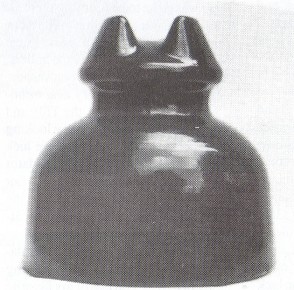
6-5/8" X 4-1/2"
CD 625 ISOREX / 310
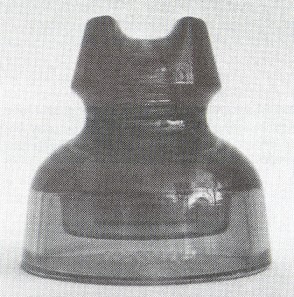
4-1/2" X 4-1/2"
CD 626
FOLEMBRAY / No. 1306
NEW FRIEND FROM "DOWN UNDER" AIDS RESEARCH
"UP FRONT"
Fairly recently, I began corresponding with Mike Hornabrook, a sheep and wool
farmer who lives in the town of Casterton, right on the state border between
Victoria and South Australia. Mike, 59, says "I have been picking up or
pulling down telephone insulators all my life, and fairly surreptitiously until
the last few years. We (he and his wife Gil) began generating our own 32 volt
home power and light in 1947 and the State Grid connected this area about 1967,
so electric power insulators have never interested me -- nasty, bitey stuff,
even fatal! With the rapid disappearance of overhead phone lines over the last
30 or so years, insulator gathering is just about done. But I keep trying,
concentrating on Australian telephone and telegraph insulators of glass and
porcelain. I have also gathered a few from New Zealand." Judging from the
photos Mike has sent, he has quite a large collection of some mighty fine
insulators and we have made some good trades. He was most anxious to acquire
some good insulator reference books and I was happy to have the insulators he
sent.
Since Mike is in a position to do some research on local insulator
manufacturers, he has put together some information on SUNSHINE POTTERIES near
Melbourne and will pass that on to me for sharing with you sometime in the near
future. In the meantime, he was able to identify a marking that both Bernie
Warren and I had wondered about for a long time. Are you reading, Bernie??
The
letters WP followed by a date of '51 appear as a dark blue underglaze ink stamp
on the crown tops of a U-1145 and a U-1160 in Mike's collection. He also has a
second U-1145 marked similarly, but with only the letter W, and this one has a date
of '52, probably when the P was dropped. Two independent but
reliable sources have told Mike that these markings identify the insulators as
products of the WELLAND POTTERIES, which operated in the Adelaide, South Australia area. However, for some reason, their insulator products
were inferior and consistently failed Post Master General (TELECOM) tests
and so the company stopped making insulators. Mike feels that possibly these two
styles were the only ones produced by WELLAND POTTERIES. At the moment, I have no other dates or information on the history or present status
of this company, but we'll be waiting to hear whatever else he can tell us.
Mike did send a photo of his insulators, but I was not sure it
would print well, so have included one here showing both styles from my own
collection. The only one that bears the mark of WELLAND is the U-1160 on the
left. The U-1145 to the right is there merely for identification, darn it!
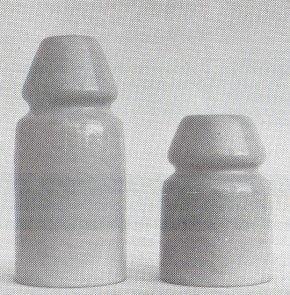
U-1160 on the left; U-1145 on the right.
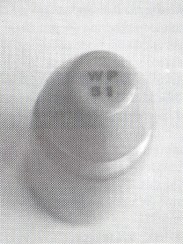
WP followed by 51, a dark blue underglaze
ink stamp on the crown top
of a U-1160.
TREASURES FROM LATVIA, USSR
Dwayne Zimmermann of Topeka, Kansas, has acquired a couple of interesting U-1710's from Russia and wrote to tell me about them. Here is a copy of his
letter:
"My son studied at Riga University early this year and brought two
porcelain insulators back for my collection. He was in Riga, Latvia (Soviet
Union) from 2/4/91 to 6/6/91 as part of a Baltic Studies Program from Emporia
State University, Emporia, Kansas.
He had shinnied up an old pole and managed to
work off a small porcelain insulator and dropped it to the ground. As he watched,
from the pole, the insulator started to roll down a slope towards a nearby river. As
you already figured out it proceeded to roll into the river and he couldn't
retrieve it.
The two insulators he brought home were found in Riga, Latvia in a
rail yard."

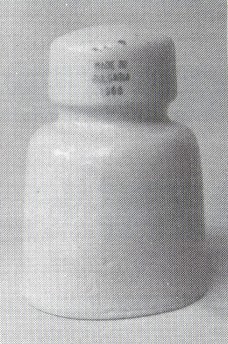 |
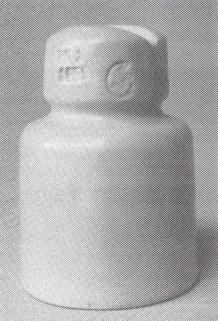 |
|
U-1710 (above) is stamped, green ink, white porcelain. It measures 4-
7/16" by 3" base diameter. It is marked above the wire groove as
follows: |
U-1710 (above) is a white porcelain stamped above the wire groove, incuse.
The top doesn't sit straight, 4-3/8" tall on one side and 4-1/8" tall
on the other side with a 2- 15/16" base diameter. |
 |
 |
I did eventually borrow these and had the pleasure (you heard right) of being
allowed to clean them. While I cannot attribute either of these markings to a
particular manufacturer or user, it was a good opportunity to copy them and take
photos of the insulators for future reference and hopefully one of my contacts
in Europe can give us some help. Maybe someone out there in readerdom knows the
answer? Many thanks to John, Mike and Dwayne for sharing!
IMPORTANT ANNOUNCEMENT: A letter has been located in a museum in the
Northwest, establishing the date and origin of M-2150, the "Mysterious Eaved
Insulator", also known as the KOOTENAY WHITE (see my column April 1990
CROWN JEWELS). The full report is not yet in, but I have been asked by the
collector who will eventually write that account to tell you this much, and this
much only,.....for now. The insulator dates from about 1901 and it originated in
Germany. Watch for further details!
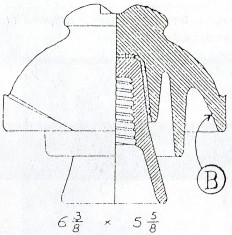
| 